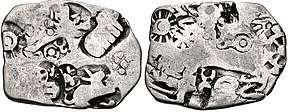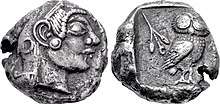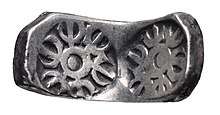Kabul hoard
| Chaman Hazouri hoard | |
 | |
 Shown within Afghanistan | |
| Coordinates | 34°30′53.28″N 69°11′42″E / 34.5148000°N 69.19500°ECoordinates: 34°30′53.28″N 69°11′42″E / 34.5148000°N 69.19500°E |
|---|---|
| Type | Coin hoard |
The Kabul hoard, also called the Chaman Hazouri, Chaman Hazouri or Tchamani-i Hazouri hoard,[2] is a coin hoard discovered in the vicinity of Kabul, Afghanistan. The hoard, discovered in 1933, contained numerous Achaemenid coins as well as many Greek coins from the 5th and 4th centuries BCE.[3] Approximately one thousand coins were counted in the hoard.[2][4] The hoard is dated to approximately 380 BCE as no coins of the hoard were beyond that date.[5]
This numismatic discovery has been very important in studying and dating the history of the coinage of India, since it is one of the very rare instances when punch-marked coins can actually be dated, due to their association with known and dated Greek and Achaemenid coins in the hoard.[6] The hoard proves that punch-marked coins existed in 360 BCE, as also suggested by literary evidence.[6]
Description of the hoard
The hoard suggests, together with other coin finds in the areas of Afghanistan and Pakistan that Greek coins had found their way to India, at least as far as the Indus, well before the conquests of Alexander the Great.[3] This happened under the rule of the Achaemenids, since they were in control of the areas as far as Gandhara.[5]
Many of the coins were stored by the Kabul Museum. Among them Daniel Schlumberger recorded 30 coins from various Greek cities, about 34 from Athens with one local imitation, 9 royal Achaemenid coins (siglos) and 14 punch-marked coins in the shape of bent bars, as well as 29 coins of a new, previously unknown, kind.[2] It seems that the Classical Greek and Achaemenid coins were not minted locally but were probably rather imported from the west.[5] According to Joe Cribb, these early Greek coins were at the origin of Indian punch-marked coins, the earliest coins developed in India, which used minting technology derived from Greek coinage.[3]
Achaemenid siglos coins
Several Achaemenid sigloi coins were found in the hoards of Kabul (dated circa 350 BCE) and Bhir Mound (dated circa 300 BCE), which likely originated in the western part of the Achaemenid Empire.[3] They typically show a crowned Achaemenid king running to right, holding bow and spear, with a rectangular punch-mark on the reverse.[3]
Achaemenid round punch-marked coins

The 29 coins "of a new kind" inventoried by Schlumberger are round or elliptic/ cup-shaped coins of the Achaemenid weight standard, struck with one, two or several punches.[5] These round coins usually display a sort of arrow symbol on the obverse, and circular geometric symbols on the reverse. Many of these coins were found in the Chaman Hazouri hoard.[3] On the contrary these rare coins were not found in the hoard of Taxila further to the east.[8]
Achaemenid punch-marked "bent-bars"
The round punch-marked coins have been shown to precede chronologically the "bent bars", also minted under Achaemenid rule from Bactria to the Punjab.[5] The practise of using silver bars for currency seems to have been current in the Achaemenid Empire.[9] These Achaemenid "bent-bars" discovered in Chaman Hazouri use two circular symbols punched at each end of one face of the bar.[3] Many of them have been found in the Chaman Hazouri hoard, as well as in the Bhir Mound hoard in Taxila.[3] These bent bars are clearly reminiscent of later punch-marked Indian types, which use several of the designs of these coins "of a new kind".[5]
According to Joe Cribb the earliest punched-marked bent-bars are found in the northwest of the continent, and their simple designs was then adopted in the Gangetic plains, before designs evolved there towards the usage of more numerous punches on each coin.[9] This is also proven by the fact that the Gangetic plains have no known coin designs anterior to their simple punch-marked bars, whereas the Kabul/Gandhara punch-marked bars were preceded there by the round punch-marked coins with symbols, minted under the Achaemenids.[9]
Daniel Schlumberger too considers probable that punch-marked bars, similar to the many punch-marked bars found in northwestern India, initially originated in the Achaemenid Empire, rather than in the Indian heartland:
“The punch-marked bars were up to now considered to be Indian (...) However the weight standard is considered by some expert to be Persian, and now that we see them also being uncovered in the soil of Afghanistan, we must take into account the possibility that their country of origin should not be sought beyond the Indus, but rather in the oriental provinces of the Achaemenid Empire"
Impact on the dating of Indian punched-marked coins

There is uncertainty regarding the actual time punch-marked coinage started in India, with proposals ranging from 1000 BCE to 500 BCE.[10] However, the study of the relative chronology of these coins has successfully established that the first punch-marked coins initially only had one or two punches, with the number of punches increasing over time.[10]
According to Joe Cribb, the study of the Chaman Hazouri hoard suggests that Indian punch-marked coins may only go back to the mid-4th century BCE or slightly earlier, and actually started with the punch-marked coinage of the Achaemenids in the Kabul/ Gandhara area.[10] This date remains consistent with various literary works mentioning the usage of coinage in India.[10] This early design was then adopted in the Gangetic plains to evolve towards multi-punch-marked coins.[10]
Another find that can be dated was made in Kausambi, where silver-plated forgeries imitating the early types of punch-marked coins and bars from Chaman Hazouri were found in the Mauryan Empire levels associated with the Pillar of Ashoka that can be found there. This is another indication that the earliest punch-marked coins only date from around the mid-4th century BCE, and that they were still the standard coinage of reference at the time of the early Mauryan Empire (mid-3rd century CE).[10]
Connected findings
In 2007 a small coin hoard was discovered at the site of ancient Pushkalavati (Shaikhan Dehri) in Pakistan. The hoard contained a tetradrachm minted in Athens circa 500/490-485/0 BCE, together with a number of local types as well as silver cast ingots. The Athens coin is the earliest known example of its type to be found so far to the east.[11]
._Period_of_Achaemenid_Rule._Circa_5th_century_BCE.jpg)
 Athens coin (Circa 500/490-485 BCE) discovered in Pushkalavati. This coin is the earliest known example of its type to be found so far east.[14]
Athens coin (Circa 500/490-485 BCE) discovered in Pushkalavati. This coin is the earliest known example of its type to be found so far east.[14]
See also
External links
Photographic inventory of the Kabul hoard in the Kabul Museum (now disappeared after looting in 1992-1994), by Daniel Schlumberger in Trésors Monétaires d'Afghanistan (1953):
References
- ↑ Errington, Elizabeth; Trust, Ancient India and Iran; Museum, Fitzwilliam (1992). The Crossroads of Asia: transformation in image and symbol in the art of ancient Afghanistan and Pakistan. Ancient India and Iran Trust. p. 56. ISBN 9780951839911.
- 1 2 3 Bopearachchi, Osmund. “Coin Production and Circulation in Central Asia and North-West India (Before and after Alexander’s Conquest)”. pp. 300–301.
- 1 2 3 4 5 6 7 8 9 10 11 Errington, Elizabeth; Trust, Ancient India and Iran; Museum, Fitzwilliam (1992). The Crossroads of Asia: transformation in image and symbol in the art of ancient Afghanistan and Pakistan. Ancient India and Iran Trust. pp. 57–59. ISBN 9780951839911.
- ↑ US Department of Defense
- 1 2 3 4 5 6 7 Bopearachchi, Osmund. “Coin Production and Circulation in Central Asia and North-West India (Before and after Alexander’s Conquest)”. pp. 308-.
- 1 2 Cribb, Joe. Investigating the introduction of coinage in India- a review of recent research, Journal of the Numismatic Society of India xlv (Varanasi 1983), pp.80-101. pp. 85–86.
- ↑ CNG Coins
- ↑ Cribb, Joe. Investigating the introduction of coinage in India- a review of recent research, Journal of the Numismatic Society of India xlv (Varanasi 1983), pp.80-101. pp. 98–101.
- 1 2 3 Cribb, Joe. Investigating the introduction of coinage in India- a review of recent research, Journal of the Numismatic Society of India xlv (Varanasi 1983), pp.80-101. pp. 98–101.
- 1 2 3 4 5 6 7 Cribb, Joe. Investigating the introduction of coinage in India- a review of recent research, Journal of the Numismatic Society of India xlv (Varanasi 1983), pp.95-101. pp. 85–86.
- ↑ CNG Coins
- ↑ CNG Coins
- ↑ CNG Coins
- ↑ CNG Coins

